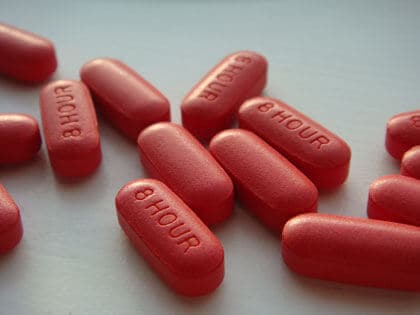New research could help reverse deadly side effects caused by excessive doses of the drug acetaminophen, the major ingredient in Tylenol and many other over-the-counter and prescription medicines.
Researchers at Duke University have developed a mathematical model of acetaminophen metabolism based on data from lab rats. The findings suggest that giving patients glutamine — a common amino acid in the body — alongside the standard antidote for acetaminophen overdose could prevent liver damage and boost the body’s ability to recover.
The results appear online and are scheduled to be published in the July 2015 issue of the Journal of Theoretical Biology.
Known for relieving minor aches and pains without upsetting the stomach like some other pain medicines, acetaminophen is a major ingredient in Tylenol and more than 600 other store brand pain relievers, fever reducers, cold remedies and allergy medicines, as well as prescription painkillers like Percocet and Vicodin.
One in four people in the U.S. take at least one acetaminophen-containing product a week. More than 27 billion doses of acetaminophen-containing products were sold in the U.S. in 2009 alone, making it the most widely-used over-the-counter or prescription drug in the country.
Available without a prescription for more than 50 years, the drug is safe when used as directed. But taking more than the maximum recommended dose of four grams per day can damage the liver. In extreme cases patients die unless they get a liver transplant.
More than 44,000 people end up in the emergency room and four hundred people die in the U.S. each year as a result of acetaminophen overdose. Many cases involve children or infants whose parents accidentally measure the wrong dose in the middle of the night, or combine different medicines without realizing that they all contain the same ingredient — for example, Tylenol for a fever and then a second medicine for a cough.
To find out if tweaking current overdose protocols could prevent fatal liver damage, Duke mathematicians Lydia Bilinsky and Mike Reed and Duke biologist Fred Nijhout developed a mathematical model of acetaminophen metabolism, based on previous studies of lab rats given high doses of the drug.
Acetaminophen is broken down in the body into several byproducts, one of which can be toxic to the liver.
At normal doses, the liver is able to clean this toxin from the body with the help of a naturally-occurring protective molecule called glutathione. Trouble starts when the recommended dose of acetaminophen is exceeded, and the body’s natural detox process requires more glutathione than the liver can make.
The standard antidote for acetaminophen overdose is a drug called N-acetylcysteine, or NAC, which helps restore glutathione levels to normal by adding the glutathione precursor that is usually in shortest supply.
But by modeling the dozens of biochemical reactions involved in synthesizing, transporting and breaking down glutathione in the body, the researchers found that the rarest ingredient changes over time.
Most of what the body needs to make glutathione comes from three amino acid precursors — glycine, glutamate and cysteine. Usually the glutathione precursor in shortest supply is cysteine, which is also found in NAC.
But the researchers discovered that after an overdose, liver cells turn on a gene that shuttles desperately-needed cysteine into the cell but pumps glutamate out, until eventually glutamate levels start to run low, too.
To test the model, the researchers plan to treat overdosed mice with different relative concentrations of NAC and glutamine — which the liver converts to glutamate — to see which dosing combinations maximize their survival.
“NAC has been the standard antidote for acetaminophen overdose for decades, and we are excited at the chance of improving it,” the authors said. The research was supported by grants from the National Science Foundation (EF-1038593, DMS-0943760) and the National Institutes of Health (R01 ES019876).


